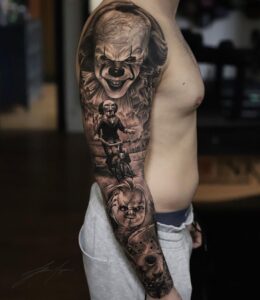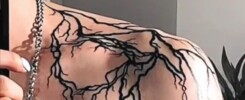-

- Popular Themes in Horror Tattoos
- Classic horror movie characters
- Gothic and macabre imagery
- Mythical creatures and legends
Horror Tattoos: Embracing the Macabre Through Body Art
Introduction
Horror Tattoos have carved out a unique niche in the world of body art. Combining elements of fear, fascination, and artistic expression, these tattoos have grown in popularity among those who appreciate the darker side of life. Let’s dive into the world of Horror Tattoos and explore their history, significance, and impact.

What are Horror Tattoos?
Horror Tattoos are a style of tattooing that incorporates themes from horror movies, gothic literature, and macabre imagery. These tattoos often feature detailed and dramatic designs, showcasing elements such as skulls, monsters, and eerie landscapes. The emphasis is on creating a sense of fear and fascination through intricate artistry.
The History of Horror Tattoos
Horror Tattoos have their roots in traditional tattoo culture, where sailors and adventurers would get tattoos of mythical creatures and fearsome symbols. Over time, as horror films and literature gained popularity, these elements began to find their way into tattoo art. The 1970s and 1980s saw a surge in horror-themed tattoos, fueled by the success of classic horror movies and the rise of the gothic subculture. Today, tattoos continue to evolve, blending classic motifs with modern artistic techniques.
Cultural Significance
Horror Tattoos hold a special place in pop culture, often representing a deep connection to the horror genre. For many, these tattoos are a way to pay homage to their favorite horror movies, books, and characters. They also serve as a form of self-expression, allowing individuals to embrace their fascination with the macabre and the supernatural.

Design Elements in Horror Tattoos
Common motifs in Tattoos include skulls, ghosts, monsters, and dark landscapes. These elements are often rendered in a highly detailed and realistic style, with an emphasis on shading and contrast to create a sense of depth and drama. Artistic techniques such as black and grey shading, color realism, and neo-traditional styles are commonly used to bring these designs to life.
Popular Themes in Horror Tattoos
- Classic Horror Movie Characters: Iconic figures like Dracula, Frankenstein’s monster, and Freddy Krueger are popular choices for Tattoos, capturing the essence of these beloved horror legends.
- Gothic and Macabre Imagery: Dark and eerie elements such as ravens, tombstones, and haunted houses are staples of Horror Tattoos, adding a gothic flair to the designs.
- Mythical Creatures and Legends: Werewolves, vampires, and other mythical beings are commonly depicted in Horror Tattoos, drawing inspiration from folklore and legends.

The Artistic Side of Horror Tattoos
Creating a Horror Tattoo requires a high level of skill and artistry. Tattoo artists use a variety of techniques to achieve the detailed and dramatic effects characteristic of this style. Fine line work, meticulous shading, and strategic use of color are essential to bringing these designs to life. The result is a tattoo that not only captures the essence of horror but also stands out as a work of art.
The Positive Aspects of Horror Tattoos
One of the main positives of Horror Tattoos is their unique artistic expression. These tattoos allow individuals to showcase their love for the horror genre and stand out with distinctive and memorable designs. Additionally, Horror Tattoos can foster a sense of community among horror enthusiasts, creating connections through shared interests and passions.

The Negative Aspects of Horror Tattoos
Despite their artistic value, Horror Tattoos can sometimes be misunderstood or negatively perceived. They may be associated with darker, more controversial themes, leading to misconceptions about the individual’s personality or intentions. It’s important for those considering a Horror Tattoo to be aware of these potential perceptions and to choose designs that genuinely resonate with them.
- Pain and Discomfort:
- The process of getting a Horror Tattoo can be painful, especially with intricate designs and shading. The level of discomfort varies depending on the tattoo’s size and placement.
- Infection:
- If the tattooing equipment is not properly sterilized or if aftercare instructions are not followed, there is a risk of infection. Signs of infection include redness, swelling, pus, and increased pain.
- Allergic Reactions:
- Some people may experience allergic reactions to the tattoo ink. This can cause symptoms like itching, redness, and swelling. In rare cases, it may lead to more severe reactions.
- Scarring:
- Improper tattooing techniques or inadequate aftercare can result in scarring. This can affect the tattoo’s appearance and may require additional treatments to correct.
- Granulomas and Keloids:
- Granulomas, which are small lumps that form around ink particles, and keloids, which are overgrowths of scar tissue, can develop in some individuals.

- Fading and Discoloration:
- Over time, Horror Tattoos may fade or change color, especially if exposed to excessive sunlight or not properly cared for. This can alter the tattoo’s original appearance.
- Skin Conditions:
- Tattoos can sometimes exacerbate existing skin conditions such as eczema or psoriasis. Additionally, the tattooing process might cause flare-ups of these conditions.
- Emotional Impact:
- While not a physical side effect, individuals might experience regret or dissatisfaction with their tattoo, especially if it doesn’t turn out as expected or if perceptions change over time.
- Social Stigma:
- Horror Tattoos can sometimes be associated with negative stereotypes or misconceptions, which might affect how individuals are perceived by others.
- Long-Term Effects:
- Over many years, tattoos can undergo changes in appearance due to aging skin, which can affect the clarity and detail of the design.
Choosing a Horror Tattoo Artist
Selecting the right artist for a Horror Tattoo is crucial. Look for an artist with experience in this specific style and a portfolio that showcases their ability to create detailed and dramatic designs. A skilled artist will understand the nuances of Horror Tattoos and be able to bring your vision to life with precision and artistry.

Preparing for Your Horror Tattoo
Before getting a Horror Tattoo, spend time researching and selecting a design that holds personal significance. Consider the placement of the tattoo, as this can affect the overall impact and longevity of the design. Consulting with your chosen artist can help you refine your ideas and ensure that the final tattoo meets your expectations.
he Tattooing Process
The process of getting a Horror Tattoo involves several steps. The artist will start with an outline of the design before moving on to the detailed shading and coloring. The session length can vary depending on the complexity of the tattoo, and pain levels can differ based on the placement and individual tolerance. Proper pain management and aftercare are essential for a smooth healing process.
Aftercare Tips for Horror Tattoos
Taking care of your Horror Tattoo is crucial for ensuring its longevity and vibrancy. Follow your artist’s aftercare instructions, which typically include keeping the tattoo clean, moisturized, and protected from the sun. Avoid picking at scabs and allow the tattoo to heal naturally to prevent any damage or scarring.
Frequently Asked Questions
1. Are Horror Tattoos only for horror enthusiasts? No, anyone can get a Horror Tattoo. However, it’s important to choose a design that genuinely resonates with you and reflects your interests.
2. How long do Horror Tattoos take to heal? The healing process typically takes 2-4 weeks, but it can vary depending on the size and complexity of the tattoo.
3. Can Horror Tattoos be colored? Yes, Horror Tattoos can be done in both black and grey or vibrant colors, depending on the desired effect.
4. Do Horror Tattoos hurt more than other styles? Pain levels can vary, but the detailed shading and intricate designs of Horror Tattoos can be more uncomfortable than simpler tattoos.
5. How do I care for my Horror Tattoo? Follow your artist’s aftercare instructions, which usually include keeping the tattoo clean, moisturized, and protected from the sun.


